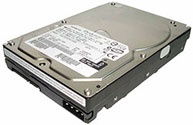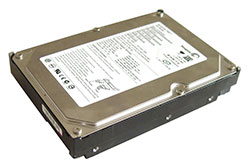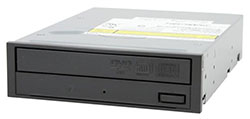Buyer's Guide: Mid-Range to High-End, May 2005
by Jarred Walton on May 23, 2005 5:30 PM EST- Posted in
- Guides
Storage Recommendations
There hasn't been a whole lot of change in the storage segment in terms of new products. Prices have dropped, but the recommendations overall remain about the same. Our recent Price Guide covered the storage market in more detail, and we'll refer interested readers there. The basic summary is that the HDD scene has not changed too much, and the DVDR scene has changed even less. The good news is that it means it's less difficult to pick a good product, which is especially true of DVDRs. The bad news is that I/O intensive tasks will still be waiting on the drives as much as ever.A topic that also deserves mention in regards to hard drives is RAID (Redundant Array of Inexpensive Disks). RAID can allow for either increased transfer rates, improved reliability, or both. RAID 0 provides increased performance by reading and writing to multiple drives at the same time in a process called striping, effectively doubling the sustained transfer rate for two drives. The problem is that if any drive in a RAID 0 configuration fails, you lose all the data. That's definitely not something to take lightly. RAID 1 goes the other route and provides a 1 for 1 copy of everything written to the hard drives, a.k.a. mirroring. In the event of a drive failure, the faulty drive is deactivated and you run with one drive until a replacement can be found. The drawback is that you now pay twice as much per GB of available storage. RAID 1+0 (sometimes called RAID 10) combines both striping and mirroring, but it requires at least four drives for the standard setup and you still only get half the realizable storage. RAID 5 is the most common remaining option, requiring a minimum of three drives to function. Only one of the drives in the array becomes "lost" capacity, but you need a good (re: expensive) controller to get acceptable RAID 5 performance. We don't really feel that RAID is something most people need, and a good backup strategy - to CDs or DVDs, usually - is often just as important as redundancy. Still, the option is there for those who need it.
Mid-Range HDD Recommendation
Hard Drive: Seagate 250GB 7200.8 SATA
Price: $128 Shipped
Picking a good hard drive for the Mid-Range market is relatively easy. You want a low cost per GB, and for the most part, the different brands all perform at close to the same level. Provided that you get a hard drive that has Fluid Dynamic Bearings (FDB), you shouldn't have to worry about any high pitched whine emanating from your computer. (This was a problem in the past, particularly with Western Digital and Maxtor drives.) Unless you're trying to build a truly silent PC, the amount of noise generated by the heads moving around will normally be drowned out by the noise of the GPU, CPU, and case fans - even the noisiest of drives is difficult to hear when confined within an ATX case. Just to make this clear, we mean that seek noise is difficult to hear, not bearing noise; we have numerous older drives that emit a high-pitched whine that can be heard a couple of rooms away.
Our recommendation goes to the Seagate model for several reasons. Besides being spacious and quiet, it provides NCQ support and a 5-year warranty, all at a price that's just as low as any of the competition. If you are for some reason opposed to 250GB hard drives, you can find everything from 80GB to 200GB at a lower price than the Seagate 250GB (depending on model and brand). The smaller drives end up coming with a higher cost per GB, however, to the point where anything less than 80GB isn't worth considering. $60 for an 80GB drive is still a reasonable deal, but you can double the capacity for only a 50% price increase. Other than Seagate, we like Samsung drives due to their even lower noise levels. Hitachi, Maxtor, and Western Digital are all decent as well, but we would suggest that you make sure you get FDB with the Maxtor and WD drives. SATA-2 drives are also starting to show up at retail, and while they may not offer a performance advantage, the price difference is negligible. Hitachi is the only manufacturer currently showing up in our Pricing Engine, although that will change with time.
 |
 |
 |
| Click images to enlarge. | ||
High-End HDD Recommendations
Hard Drive: Western Digital Raptor 74GB 10,000RPM SATA
Price: $180 Shipped
Hard Drive: Maxtor DiamondMax 10 250GB 16MB SATA
Price: $160 Shipped
Hard Drive: Hitachi 7K250 400GB SATA
Price: $265 Shipped
There are three areas that we consider to be high end for hard drives. First is the option for a faster spindle speed, leading to faster transfer rates and access times. 10,000RPM SATA and SCSI drives are available, but the SATA drives are cheaper and don't require an additional SCSI controller. You can even go for a 15,000RPM SCSI drive, although the cost is twice as much (or more) as that of the 10,000RPM drives of the same capacity. The next item that makes a hard drive high end is additional cache, and at present, the only manufacturer to fill that niche is Maxtor, with both its SATA and PATA MaxLine III/DiamondMax 10 models including 16MB of cache rather than 8MB. The final item that can make a high end drive is increased capacity, with 300 to 400 GB drives now available. Increased capacity via higher data densities also improves the transfer rate of a drive, although it doesn't help the access times. Determining which of these features are the most important along with keeping price in check is difficult. Sure, you can get 146GB 15,000RPM SCSI drives to satisfy the need for performance and capacity, but at a cost of over $1000 per drive, they're not meant for mere mortals.
In the end, we can't really give one specific recommendation for a high end drive. If you need capacity above all else, the Hitachi 7K250 400GB will fit the bill. Seagate also offers a 400GB 7200.8 drive for about $25 more if you're interested. Striking a middle ground between performance and capacity is the Maxtor DiamondMax 10 line, of which we've selected the 250GB model. The 300GB model has a similar cost per GB, so if you want a bit more capacity, that's definitely an option. While we don't care too much for the old IDE interface, we should also note that the Maxtor drives are available in PATA format for quite a bit less. Finally, if you're only interested in having the highest possible sustained transfer rate and access times, the Western Digital Raptor 74GB gets our recommendation again. 15,000RPM SCSI drives would be even faster than the Raptor, but they start at around $400 for the Hitachi 15K73 and go up from there - twice as much as the Raptor, not counting the cost of SCSI controllers and cables.
Optical Recommendation
DVD+R Drive: NEC 16X 3520A
Price: $48 Shipped
With 16X burn speeds for both DVD+R and DVD-R media and 8X/6X for the respective RW variants, the only thing really missing from the NEC 3520A is DVD-RAM support. If you need or want that, the LG GSA-4163B has 5X DVD-RAM support for just a few dollars more. Either drive will work well for most people, and while some will argue that Plextor or Sony drives are better, we haven't been able to back up such claims with any tests. Given the higher price - over twice as much in the case of the Plextor 16X - we cannot justify such a purchase. Pioneer's DVR-109 is another alternative, and Lite-On, Toshiba, and BenQ are also worth considering, assuming that the price is right. We feel that features and performance are all now close enough that we'd simply take the cheapest 16X DVDR Dual-Layer capable drive and be done with it, which is why the NEC and LG get our recommendation. As always, match the color of the drive with your case if that's important to you.
Floppy Recommendation
Floppy: Any
Price: $8 Shipped
When you're spending this much money on a nice, new system, it's almost a shame to have to put in old technology like a floppy drive. While not strictly required, we'd rather have the drive installed and never use it than to not have it and discover later that we need it. Anyone planning on using RAID will definitely want a floppy drive, as it's required for installing XP onto any RAID setup that we're aware of. Windows Longhorn should finally kill off the floppy requirement, but that's still more than a year off. $8 over 365 days amounts to just 2.2 cents per day - you can manage it, right? As with the DVDR drive, you will probably want to match the floppy to the case.












60 Comments
View All Comments
Tujan - Tuesday, May 24, 2005 - link
Err a,thanks for reply..Calin.bummer when I do that.
Garyclaus16 - Tuesday, May 24, 2005 - link
All this article tells me is that my once 'bleeding edge' [939 Athlon64 3200+]system is now merely a mid range PC...save for my pqi turbo 2-2-2-5 :PStill...I am sad...I need to save up another 2k now for later this year. > :(
Tujan - Tuesday, May 24, 2005 - link
Thanks for reply Chris..Yeah Ive followed a few stories about the VIA Edens. Just hovering around 1 GHz. With single PCI slot.They too,have onboard graphics. Like pull that off , keep onboard sound maybe,...
Certainly limiting themselves with that kind of choice.Then Im not what that is suppose to reach. Two PCI-e slots at minimum for me.But this sends the engineers back to work.
Most vendors Iv seen include the graphics onto the mini-atx motherboards. MSI has an mini-atx w/o graphics ,..775.But isn't seen at vendors. Situation with the power,could make do with feature set of 915..945,955/Nvidias on mini-atx(s),.Since the lan is onboard.Might consider having maybe single Sata as well.
Not like being able to see clearly now...""I can see clearly now the rain is gone""..:)
Weird how we will see magic in closed black box embedded solution before we have that choice.
ProviaFan - Tuesday, May 24, 2005 - link
I agree with #34 for the most part, but anyone heavily into digital photography (whether with DSLR or scanned film) knows that it is very easy to exceed 1GB with Photoshop and a few images with some adjustment layers and layer masks (not to mention that my PC is general purpose and I usually have other stuff going in the background as well).stickx - Tuesday, May 24, 2005 - link
quoted from the guide: "long-time favorite, the OCZ Rev. 2 Platinum. While the price increase is quite drastic, it's worth mentioning that this same RAM cost as much as $275 just a few months back. It uses Samsung TCCD memory blanks"Unfortunately OCZ is no longer using TCCD memory in this product. This has been verified on several forums in xtremesystems.org and in dfi-street.com where people have removed the heat spreaders to find chips other that TCCD. I think you need to update your guide for this info.
OrSin - Tuesday, May 24, 2005 - link
Damn people get off thier backs. It a damn guide. Make all the choices you. They are giving thier recommondation, they are not give you ever fcking choice under the sun. No guide can have everyones choice.And ars, I don't know what planet your from but if you think epox is even near Asus or MSI in quality then then you full of it. If i saw any sit say Exop is better then ASUS, then I would stop reading them. Better then chaintech ost likely then not the top tier guys.
And for the record I play alot games and have noticed no improvement with 2GB of 1GB or memory.
Don know what you do thet 2GB is needed. Now I'm not saying you can;t find a way to use more then 1GB, but how many people actually do and on a regular bases.
Pythias - Tuesday, May 24, 2005 - link
When you guys refer to response time, is thet grey-to-grey, black-white-black, or total response time?MrOblivious - Tuesday, May 24, 2005 - link
Supposedly the issue with MSI NEO4 boards and 90nm chips has been fixed:http://forum.msi.com.tw/index.php?topic=80384.0
arswihart - Tuesday, May 24, 2005 - link
Kris - so you are now saying all mobo makers are essentially equal in terms of support, upgrades, MTBF (bad caps excuse is dead now since they all use good/great quality caps). So what's left to make me choose Asus/MSI? If you are saying reputation, I can just direct you to the forums, their boards are no better or worse than any of the competition. If you are recommending based on sales, thats just dumb.ceefka - Tuesday, May 24, 2005 - link
#1 I don't know how the onboard will handle sound in games, but I'd count on it to do that on the level it is built, i.e. no better than it will play a CD or DVD. It is however safe to say that onboard will definately not work for (semi)professional audio on a PC.I always thought that any realtime sound effects were handled by the CPU, unless you have a dedicated DSP-card or multiples thereof which gamers seldom do ;-)
Jarred: "anyone who doesn't intend to do any recording of audio" and what about those that do? I do read a lot about DAW's on the net, but have to get back to AT regularly to get a the details straight.
What do you make of this? http://www.rme-audio.com/english/techinfo/nforce4_...
With the Thonex audio stress test file (downloadable from http://www.adkproaudio.com/downloads.cfm), including memory-intensive data communication via samples/VSTis, and used with Cubase SX/Nuendo 2/3, soundcard latency has to be increased to approx. 2048 samples buffer latency setting with the NF4 to receive glitch-free audio recordings whereas with the NF3, and equivalent software/hardware/soundware equipment, the minimum latency can be significantly reduced (some 128-256 samples). Likewise, cpu load values are significantly higher with the NF4 than with the NF3 ditto - based on exactly the same audio stress test files and equivalent hardware peripherals.
The Thonex could be nice for your next high end guide when the dualcores are out.